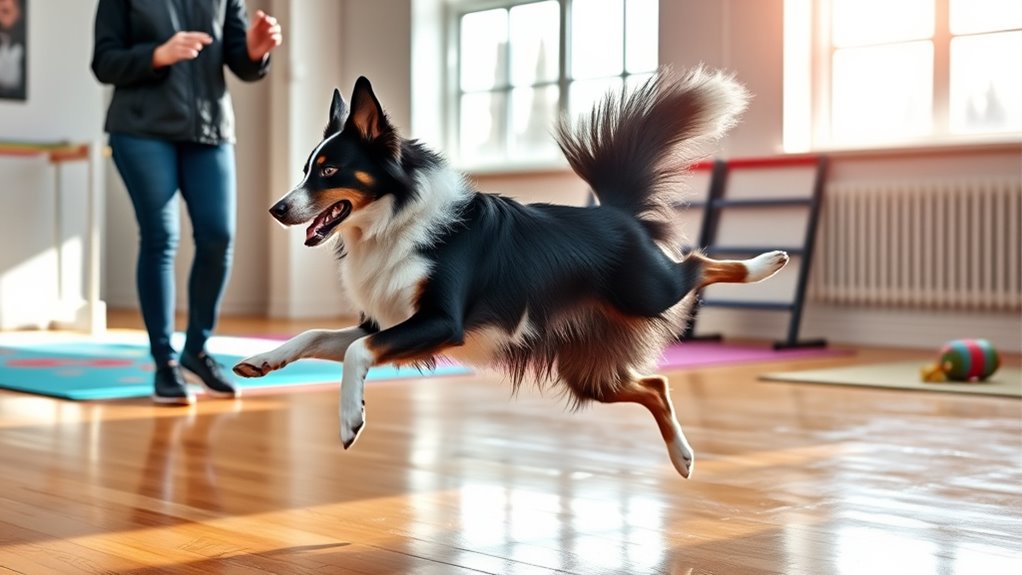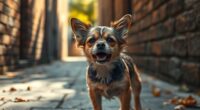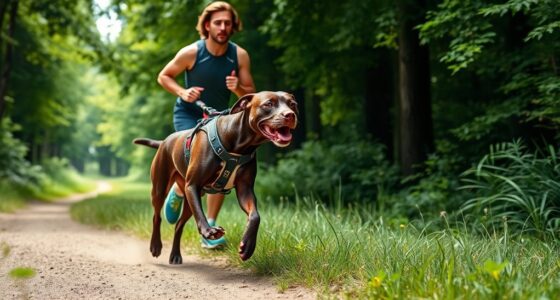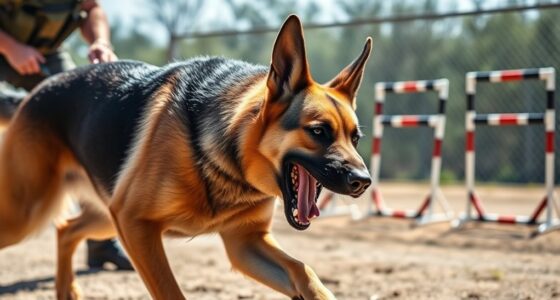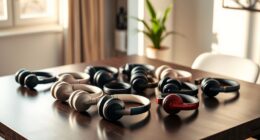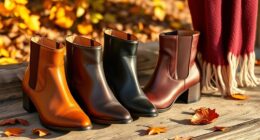To train your dog for canine freestyle, focus on building a strong bond through consistent obedience training and positive reinforcement. Use clear cues, short practice sessions, and fun routines that match your dog’s energy and music. Incorporate socialization, grooming, and creative costumes for visual appeal. Keep practicing regularly, stay relaxed, and introduce new sequences gradually. If you want to learn more about creating confident, engaging dance routines, you’re in the right place to get started.
Key Takeaways
- Establish a strong foundation with basic obedience commands like sit, stay, and heel, using consistent cues and positive reinforcement.
- Use clear, expressive body language and cues to communicate effectively with your dog during routines.
- Incorporate music that matches your dog’s energy and rhythm to improve synchronization and flow.
- Keep training sessions short, positive, and frequent to maintain engagement and reinforce learned behaviors.
- Practice routines in different environments and in front of others to build confidence and reduce performance anxiety.
Understanding the Basics of Canine Freestyle

What exactly is canine freestyle, and how does it work? It’s a fun, energetic activity where you choreograph dance routines with your dog, showcasing their agility and obedience. To succeed, you need to understand dog body language and canine communication. Dogs express themselves through tail wagging, ear positioning, and posture, which helps you interpret their mood and readiness. Recognizing these signals guarantees you’re both comfortable during training and performance. Canine freestyle relies on mutual trust and clear communication, so your dog knows when to move, pause, or change direction. By observing your dog’s body language, you can adjust your cues and build a seamless routine. This foundation in canine communication makes the activity enjoyable and strengthens your bond while creating impressive dance performances.
Essential Training Tools and Equipment
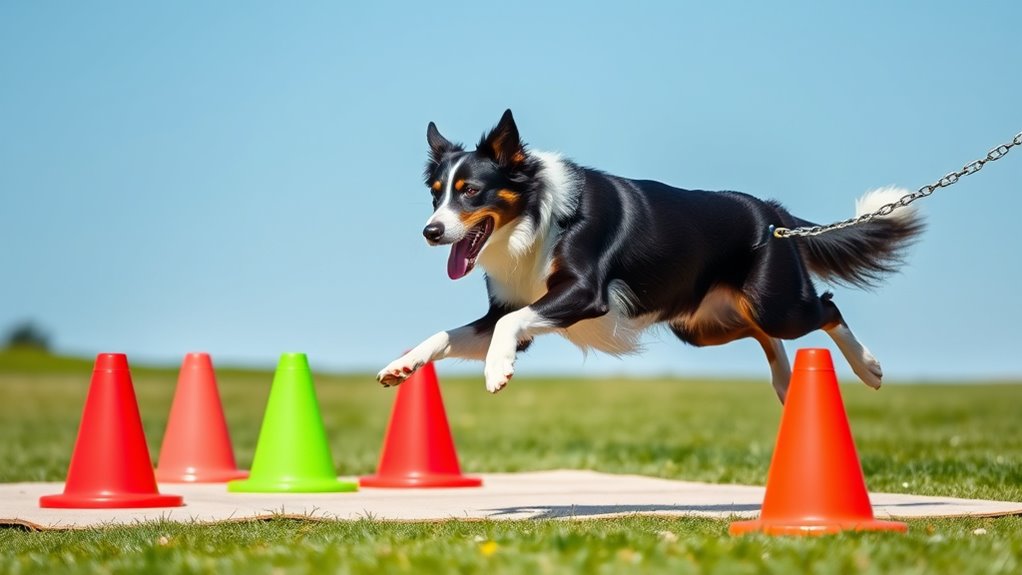
To effectively train your dog in canine freestyle, you’ll need a few essential tools and pieces of equipment that facilitate communication and performance. A good leash and collar or harness are crucial for guiding your dog during practice sessions. Treats and clickers help reinforce positive behavior and speed up learning. Consider using a mat or designated area to mark your training space. When planning routines, explore costume ideas that match your theme and make sure they comply with competition rules—comfort and safety come first. Video recording equipment can help you review routines for areas to improve. Incorporating training resources like self-watering planters into your routine for fun and cross-training can add variety and boost your dog’s energy levels. Additionally, selecting the right organization tools can help keep your training space tidy and efficient, making your sessions more productive. Having these tools on hand makes training more efficient and enjoyable, helping you and your dog perform confidently during practice and competitions.
Building a Strong Foundation With Obedience Skills
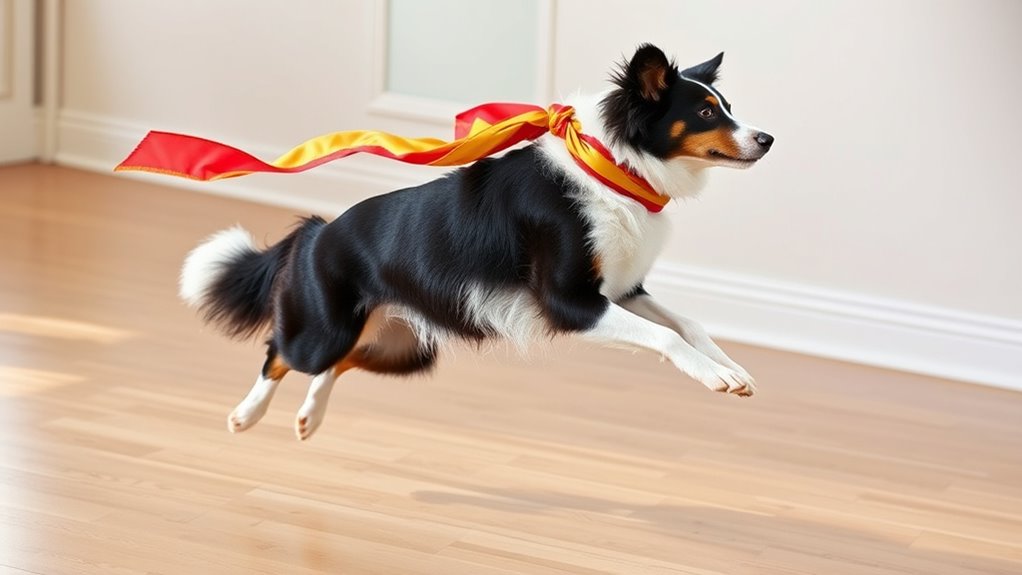
Establishing a solid obedience foundation is essential for successful canine freestyle routines, as it guarantees your dog responds reliably to your commands. You’ll need to understand dog body language to recognize signs of hesitation or distraction. Consistent reward timing reinforces good behavior and helps your dog associate commands with positive outcomes. Focus on these key areas:
- Practice basic commands like sit, stay, and heel until responses are automatic.
- Use clear, consistent cues and observe your dog’s body language for understanding.
- Reward immediately after correct behavior to strengthen learning.
- Keep training sessions short and positive to maintain your dog’s engagement and enthusiasm.
- Understanding training principles ensures your routines are effective and enjoyable. Additionally, incorporating positive reinforcement techniques promotes a strong bond and motivates your dog to perform confidently. Recognizing training consistency helps establish reliable responses and build trust during routines. Maintaining training patience is also crucial for overcoming challenges and ensuring steady progress. Applying vibrational energy awareness can further enhance your training sessions by aligning your mindset with positive outcomes.
Building this foundation assures your dog is attentive, responsive, and enthusiastic to learn new routines, making freestyle training more effective and enjoyable.
Choreographing Your Dance Routine
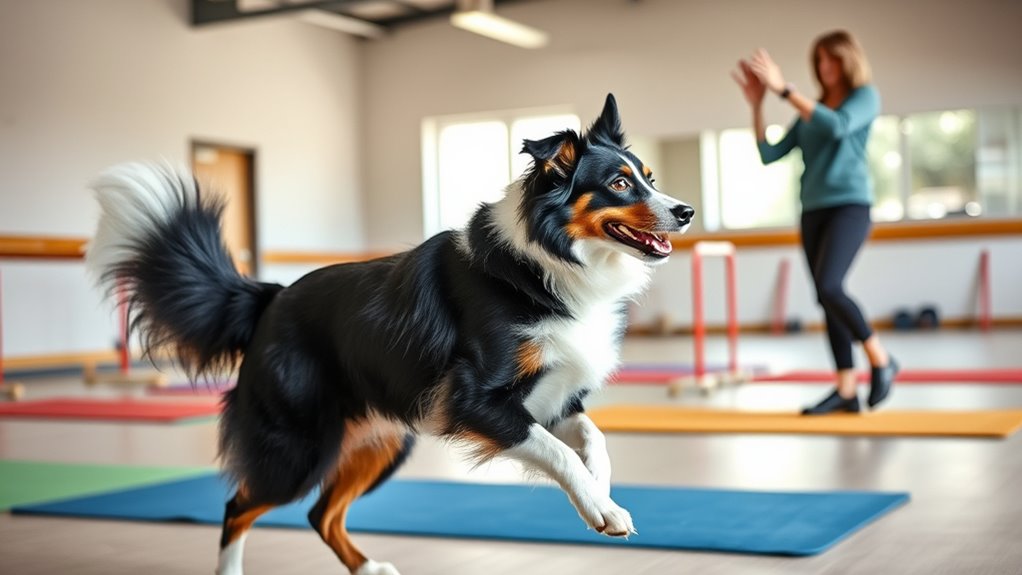
Choosing the right music and timing is key to creating a seamless routine that feels natural. Planning your sequence carefully helps your dog stay engaged and confident throughout the performance. Smooth shifts between moves make your routine look polished and keep the energy flowing. Incorporating cozy textiles can also help your dog feel comfortable and relaxed during practice sessions. Additionally, considering costume options can enhance the visual appeal and help your dog get accustomed to wearing accessories used in performances. Paying attention to financial management ensures you can invest in quality training tools and costumes without strain. Understanding sound design techniques can also help you select background music that complements your dog’s movements and adds to the overall aesthetic of your dance routine. Recognizing relationship dynamics between handler and dog can further improve synchronization and performance quality.
Music Selection and Timing
Selecting the right music is essential for creating a seamless and engaging canine freestyle routine. The music’s tempo sets the pace, so choose a track with a rhythm matching both your and your dog’s energy levels. A steady tempo helps you synchronize movements and maintain flow. When selecting music, consider how the beat aligns with your planned moves. Additionally, choosing music formulated to suit the music tempo can help maintain consistent energy levels throughout your performance. Here are key ideas to keep in mind: 1. Match the music tempo to your dog’s speed and stamina 2. Choose a song with clear, consistent rhythm matching your choreography 3. Avoid overly complex or unpredictable beats 4. Practice timing by moving in sync with the music’s rhythm to guarantee smooth progressions. Incorporating headphone compatibility options can also help you focus on the music while training. This approach enhances training focus and makes your routine more engaging. Moreover, understanding how creative practice can be applied during training sessions may improve your overall coordination and innovation in routines. Additionally, utilizing diverse music styles can inspire new movements and keep training sessions fresh and motivating.
Sequence Planning and Transitions
Planning your routine’s sequence and shifts is essential for creating a smooth and engaging performance. Focus on sequence variation to keep both your dog and audience interested. Smooth transitions rely on cue clarity, so signals should be consistent and easy to understand. Properly planning how moves flow from one to another prevents awkward pauses and enhances rhythm. Use the following table to visualize how clear cues and varied sequences work together:
| Sequence Variation | Cue Clarity |
|---|---|
| Keeps routine fresh | Ensures dog responds accurately |
| Prevents predictability | Builds confidence in cues |
| Adds complexity | Reinforces training consistency |
| Creates flow | Maintains performance momentum |
Balancing these elements results in a cohesive, captivating dance routine. Additionally, understanding training consistency helps ensure that your cues are reliable across performances, further enhancing routine fluidity. Incorporating exfoliating techniques can improve your dog’s skin health, leading to a more comfortable and confident performance. Developing emotional support strategies for your dog can also help them stay relaxed and focused during routines, reducing stress and improving overall performance quality. Recognizing the importance of routine maintenance can help keep training effective over time.
Tips for Effective Practice Sessions
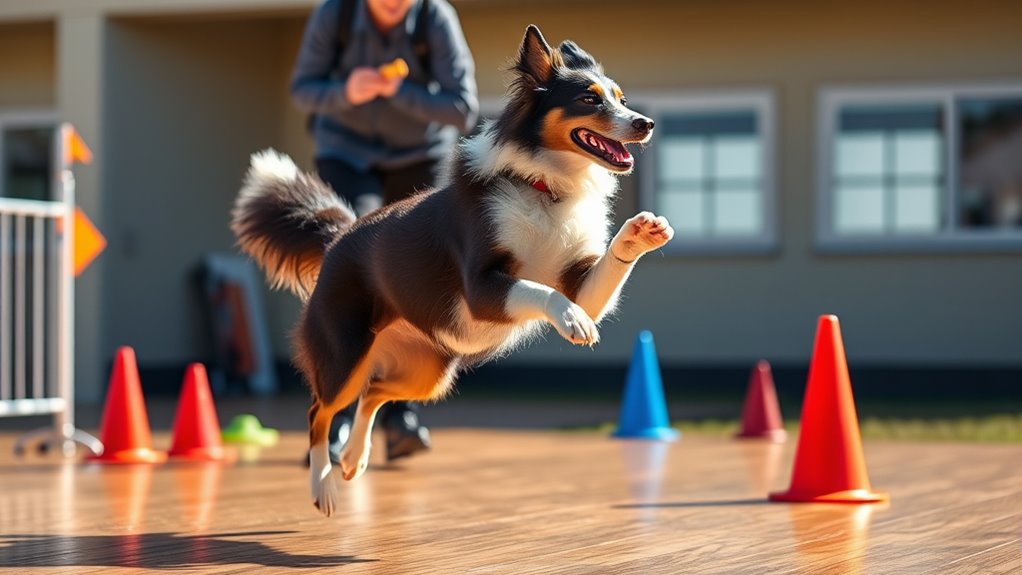
To make the most of your practice sessions, stick to a regular schedule with short, focused periods. Use clear and consistent cues so your dog understands exactly what you want. These simple steps help build better communication and keep training effective. Additionally, scheduling your training during support hours when assistance is available can provide helpful guidance if needed. Incorporating performance techniques like positive reinforcement can also enhance your dog’s learning process.
Schedule Regular Short Sessions
Because dogs learn best through consistent, focused practice, scheduling short sessions regularly can substantially boost their progress in canine freestyle. Short, frequent practice keeps your dog engaged without overwhelming them, making training more effective. During these sessions, incorporate socialization by practicing around different people and environments, helping your dog stay confident. Also, include grooming routines to reinforce positive associations with handling and touch.
Consider these tips:
- Keep sessions under 10 minutes to maintain focus.
- Practice in various locations to improve socialization.
- Use grooming as part of handling exercises to build trust.
- Stick to a consistent schedule to reinforce routines and progress.
Use Clear, Consistent Cues
Consistent cues are the foundation of effective canine freestyle training. Using clear verbal cues and visual signals helps your dog understand what you want. Always use the same word or phrase for each command, so your dog doesn’t get confused. Pair verbal cues with distinct visual signals, like hand gestures or body movements, to reinforce your message. Keep cues simple and direct, avoiding complicated language. Be consistent in your tone of voice and gestures, so your dog learns to associate them with specific actions. During practice, use the same cues every time you want a behavior. This consistency builds your dog’s confidence and speeds up learning. Clear, reliable cues make training more efficient and enjoyable for both of you.
Showcasing Your Routine and Gaining Confidence
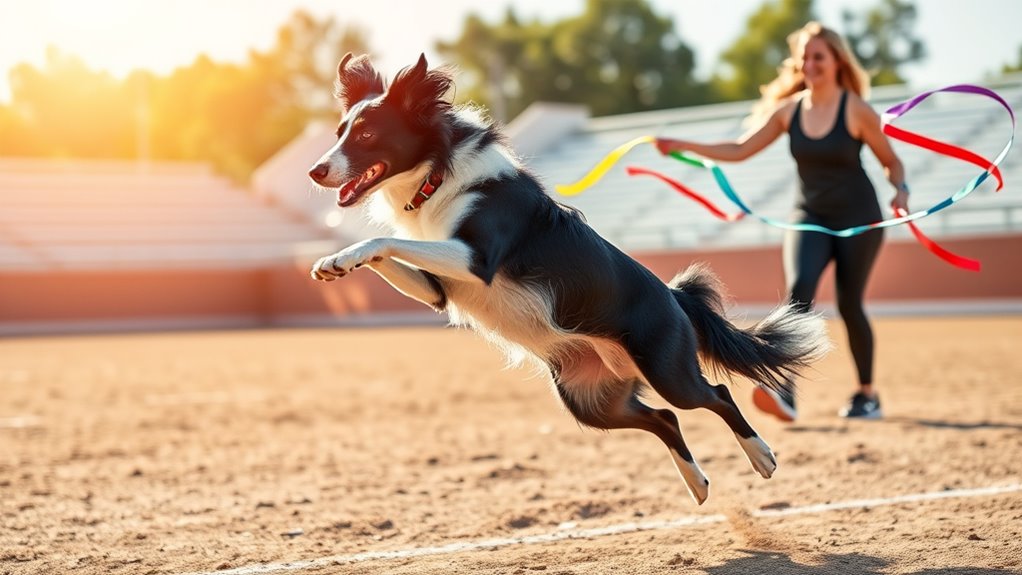
Once you’ve practiced your canine freestyle routine thoroughly, the next step is to confidently showcase it to an audience. To do this, focus on engaging your viewers and making your performance memorable. Consider creative costume ideas that complement your routine and boost your confidence. Here are some tips:
- Practice in front of friends or family to build comfort.
- Use expressive body language to connect with your audience.
- Incorporate fun costume ideas that reflect your routine’s theme.
- Stay relaxed and enjoy the moment, which helps your dog stay confident too.
Frequently Asked Questions
How Long Does It Typically Take to Train a Dog for Freestyle Routines?
Training duration varies based on your dog’s age, breed, and prior experience, but you should anticipate progress expectations of consistent practice over several months. Typically, it takes around 3 to 6 months to develop solid routines, though some dogs may learn faster or need more time. Stay patient, keep training sessions short and fun, and celebrate small milestones to ensure steady progress toward your freestyle goals.
What Are Common Mistakes Beginners Make in Canine Freestyle Training?
Many beginners stumble with canine freestyle training by making reinforcement mistakes and timing errors. You might reward your dog too early or too late, confusing them and slowing progress. Focus on consistent cues, clear communication, and precise timing. Avoid rushing routines or over-rewarding. Practice patience, stay positive, and reinforce good behavior promptly. By avoiding these common pitfalls, you’ll help your dog learn dance routines more smoothly and successfully.
Can Older Dogs Learn Dance Routines, or Is It Only for Puppies?
You might wonder if older dogs can learn dance routines, and the answer is yes. Age considerations matter, but training adaptability is key. With patience, positive reinforcement, and tailored exercises, your senior dog can pick up new tricks and enjoy the activity. Keep sessions fun and short, respecting your dog’s limits. Older dogs can thrive in canine freestyle, proving that age isn’t a barrier to learning and bonding through dance.
How Do You Motivate a Dog That Loses Interest During Training?
When your dog loses interest during training, you can boost treat motivation by using high-value treats they love. Incorporate engaging toys to make sessions fun and rewarding. Keep training sessions short and lively, switching between treats and toys to maintain their enthusiasm. Always praise your dog passionately, and be patient, celebrating small successes. This approach keeps your dog motivated and enthusiastic to learn new dance moves.
Are There Specific Breeds That Excel Better in Canine Freestyle?
Some breeds suit canine freestyle better due to their temperament traits and breed suitability. Active, intelligent breeds like Border Collies, Aussies, and Jack Russells excel because they thrive on mental stimulation and enjoy learning new tricks. However, individual personality matters most. You should choose a breed that matches your dog’s energy level and temperament, ensuring they’re motivated and happy to perform in dance routines.
Conclusion
Remember, training your dog for freestyle is like teaching a child to dance—patience and consistency are key. I once saw a dog perfectly spin on command after weeks of practice, transforming from unsure to confident on stage. With dedication, your routine will come together effortlessly, turning your dog into a graceful performer. Keep practicing, stay positive, and soon you’ll both be stealing the spotlight with your synchronized moves.

